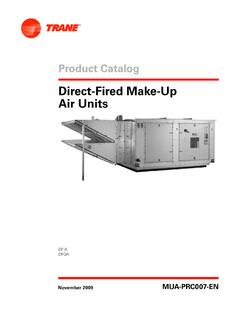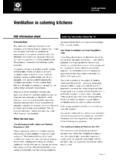Transcription of Microeconomics Topic 6: “Be able to explain and calculate ...
1 MicroeconomicsTopic 6: Be able to explain and calculate averageand marginal cost to make production decisions. Reference: Gregory Mankiw s Principles of Microeconomics , 2nd edition, Chapter versus Short-RunIn order to understand average cost and marginal cost, it is first necessary to understandthe distinction between the long run and the short run. Short run: a period of time during which one or more of a firm s inputs cannot run: a period of time during which all inputs can be example, consider the case of Bob s Bakery. Bob s uses two inputs to make loavesof bread: labor (bakers) and capital ( ovens ). (This is obviously a simplification, becausethe bakery uses other inputs such as flour and floor space. But we will pretend there arejust two inputs to make the example easier to understand.)
2 Bakers can be hired or firedon very short notice. But new ovens take 3 months to install. Thus, the short run forBob s Bakery is any period less than 3 months, while the long run is any period longerthan 3 concepts of long run and short run are closely related to the concepts of fixed inputsand variable input: an input whose quantity remains constant during the time period input: an input whose quantity can be altered during the time period the case of Bob s Bakery, ovens are a fixed input during any period less than 3months, whereas labor is a variable Cost, Variable Cost, and Total CostIn the short run, a firm will have both fixed inputs and variable inputs. These correspondto two types of cost: fixed cost and variable cost (FC): the cost of all fixed inputs in a production process.
3 Another wayof saying this: production costs that do not change with the quantity of cost (VC): the cost of all variable inputs in a production way of saying this: production costs that change with the quantity ofoutput the case of Bob s Bakery, the cost of renting ovens is a fixed cost in the short run,while the cost of hiring labor is a variable fixed inputs cannot be changed in the short run, fixed cost cannot be changedeither. That means fixed cost is constant, no matter what quantity the firm chooses toproduce in the short cost, on the other hand, does depend on the quantity the firm produces. Variablecost rises when quantity rises, and it falls when quantity you add fixed and variable costs together, you get total cost (TC): the total cost of producing a given amount of = FC + VCNote: the total cost curve has the same shape as the variable cost curve because total costsrise as output the case of Bob s Bakery, suppose the firm s rental payments on ovens add up to $40 aday; then FC = 40.
4 And suppose that if the firm produces 100 loaves in a day, its laborcost (wages for bakers) is $500; then VC = 500. The firm s total cost is TC = 40 + 500 =540. Suppose that when the firm produces 150 loaves a day, its labor cost rises to $700;then the new VC = 700 and the new TC = 40 + 700 = 740. This information issummarized in the table s Bakery s Total, Fixed, and Variable CostsQuantity(per day)Total CostFixed CostVariable Cost1005404050015074040700 Average Cost or Average Total CostAverage cost (AC), also known as average total cost (ATC), is the average cost per unitof output. To find it, divide the total cost (TC) by the quantity the firm is producing (Q).Average cost (AC) or average total cost (ATC): the per-unit cost of = TC/QSince we already know that TC has two components, fixed cost and variable cost, thatmeans ATC has two components as well: average fixed cost (AFC) and average variablecost (AVC).
5 The AFC is the fixed cost per unit of output, and AVC is the variable costper unit of = AFC + AVCAFC = FC/QAVC = VC/QIn the case of Bob s Bakery, we said earlier that the firm can produce 100 loaves with FC= 40, VC = 500, and TC = 540. Therefore, ATC = TC/Q = 540/100 = Also, AFC =40/100 = and AVC = 500/100 = 5. Notice that we can use AFC and AVC to findATC a different way: ATC = AFC + AVC = + 5 = , which is the same answer wegot Bob s Bakery produced 150 loaves instead of 100, the calculations would be the same,except we d use Q = 150, VC = 700, and TC = 740 instead. FC would still be 40. Thisinformation is summarized in the table s Bakery s Total and Average CostsQuantity(per day) s easy to find ATC using TC and Q, like we just did. But you should also be able tofind Q using TC and ATC, or find TC using Q and ATC.
6 Since we know that ATC =TC/Q, we also know that TC = ATC Q and Q = example, suppose you know that Bob s Bakery has TC = 740 and ATC = SinceATC = TC/Q, the following equation must = 740/QIf you solve the equation, you ll find that Q = 150 (approximately).Marginal CostOften, we are interested in knowing what happens to a firm s costs if output is increasedby just a small amount. This is not the same as the average cost, because the next unit ofoutput the firm produces might be more or less costly to produce than previous cost (MC): the additional cost that results from increasing output by one way of saying this: the additional cost per additional unit of use the symbol (the Greek letter delta) to designate the change in a variable. Forinstance, if total cost (TC) rose from 75 to 100, we would say TC = 100 - 75 = this symbol, we can write the mathematical formula for marginal cost:MC = TC/ QNotice that we divide by the change in quantity ( Q).
7 Often, we set Q = 1, becausemarginal cost is defined as the additional cost from one more unit of output. Butsometimes we don t know how much the added cost from just one more unit is, so wecalculate marginal cost for a larger change in the case of Bob s Bakery, we said that TC = 540 when Q = 100, and TC = 740 when Q= 150. So TC = 740 - 540 = 200, Q = 150 - 100 = 50, and therefore MC = 200/50 = say that the marginal cost is 4 for units between 100 and 150. This is assuming wedon t have information about how much it would cost to increase output by just one, from100 to 101 loaves of that the MC differs from ATC. At Bob s Bakery, the original ATC was , andthe new ATC (after increasing quantity to 150) was Neither of these is equal to theMC of 4 that we just calculated.
8 The table is the same as the last one, but with a newcolumn for s Bakery s Total, Average, and Marginal CostsQuantity(per day) that MC is listed between lines. That s because MC shows the change that resultsfrom going from the first line to the second line. But sometimes, for simplicity, MC isjust shown on the second calculating MC, notice that you use four different numbers: the old TC, the new TC,the old Q, and the new Q. You should also be able to find any one of these numbers ifyou know the other three plus the marginal example, suppose you know that Bob s Bakery had a total cost of $540 at its oldquantity of 100, and you know that Bob s has a total cost of $740 at its new quantity, butyou don t know the firm s new quantity. But you do know its marginal cost per unit inmaking the change was 4.
9 Since MC = TC/ Q, the following equation must hold:4 = (740 - 540)/(new Q - 100)If you solve the equation for new Q, you ll find that it s Typical Shapes of Cost CurvesSometimes you will need to use curves representing the different kinds of cost. Here arethe typical curve FC is constant, the FC curve is always horizontal like the one shown in the figurebelow. In our example, FC is always $40 --whether the firm produces 10 or 100 units ofoutput. Fixed Cost Curve Quantity $ FC $40 0 On the other hand, VC increases as quantity increases. As a result, any VC curve isupward sloping like the one shown in the figure below. The TC curve looks very muchlike the VC curve, except that it s higher because it includes the FC as AVC and ATC curve tend to have a U-shape, as shown in the figure below.
10 That is,both AVC and ATC tends to fall at first and then rise as the output level increases. Ofcourse, ATC is higher because it includes fixed it is not shown in the figure above, we could also draw the AFC curve. SinceAFC = FC/Q and FC is constant, AFC gets smaller and smaller as Q gets larger. Thatmeans the AFC curve is always downward also tends to have a U-shape. However, the bottom of the U occurs earlier, so theupward-sloping part of the MC is more important. The figure below shows a typical MCcurve, along with ATC and AVC. Notice that MC crosses both ATC and AVC at theirlowest and Variable Cost CurvesQuantity$VC0 TCATC and AVC CurvesQuantity$ATC0 AVCATC and AVC CurvesQuantity$ATC0 AVCMCThe figure above is the most important one for you to remember, because ATC, AVC,and MC are useful in understanding how a firm maximizes profit.














